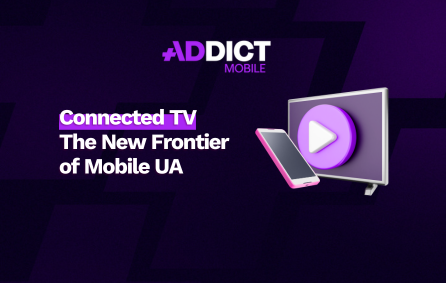CTV and Mobile UA: a channel of choice

What You’ll Learn in This White Paper
In a constantly evolving digital landscape, Connected TV (CTV) is emerging as an increasingly strategic channel for advertisers. This white paper takes a deep dive into the intersection of CTV and mobile UA, detailing the opportunities, methods, and best practices for integrating CTV into a performance-driven user acquisition strategy.

Definition and Global Adoption of CTV
We start by laying the foundation: what exactly is CTV, how does it work, and how is it different from traditional linear or cable TV? You’ll also discover how CTV adoption is evolving across the globe, with key data per region (North America, Europe, Asia, Africa) and insights into the major OTT platforms (Netflix, Hulu, Disney+, and more).
This global overview helps marketers understand where the opportunity lies, especially for mobile-first brands. A clear visual of the CTV ad ecosystem and a breakdown of market players (publishers, aggregators, AVOD/HVOD platforms) will help you grasp the strategic context for combining CTV and mobile UA effectively.
The Benefits of Combining CTV and Mobile UA
CTV is no longer reserved for upper-funnel branding. It’s now a powerful lever for user acquisition on mobile, and this section explains why.
You’ll learn:
- How CTV captures user attention in a premium, low-clutter environment.
- Why its inventory is often perceived as more trustworthy and impactful than mobile display.
- How advanced targeting (contextual, geo, behavioral, 1st-party) can help reach niche audiences.
- The strong synergies between CTV and mobile UA, including TV-to-mobile mechanisms like QR codes and deep linking.
- Why CTV can uniquely deliver both brand awareness and measurable performance — ideal for a full-funnel approach.
We also include the latest performance benchmarks showing the impact of CTV campaigns on mobile KPIs like CPI, install rate, and brand lift. If you’re looking to scale efficiently, combining CTV and mobile UA might be your next big move.
Running CTV Campaigns for App Marketing
Moving from theory to execution, this section walks you through how to effectively manage a CTV campaign with a mobile UA objective, from setup to optimization.
You’ll discover:
- Which DSPs are best for buying CTV inventory (The Trade Desk, DV360, Moloco, etc.).
- How to choose between Direct Buy and programmatic.
- The most effective formats and tracking practices (MMP integration, QR codes, post-view setups).
- How to leverage cross-device targeting to reach the right users at the right time.
- Common mistakes to avoid, such as poor frequency capping or misattribution.
This is a hands-on section packed with real-life use cases, tips, and operational frameworks — all focused on bridging CTV and mobile UA in a results-driven way.
Creative Best Practices for CTV
A successful CTV campaign depends just as much on the creative. Sitting at the intersection of TV storytelling and mobile performance, your assets need to hook quickly — and drive action.
We’ll cover:
- The key technical specs (duration, formats, file size).
- Best creative practices for CTV: short storytelling, strong branding, clear CTAs, use of QR codes, and adapting to the lean-back viewing context.
- Mistakes to avoid (like overwhelming visuals or lack of mobile alignment).
When combining CTV and mobile UA, creative becomes more than just a visual — it’s a driver of attention, conversion, and long-term brand equity.
Whether you’re a mobile marketer looking for scalable acquisition levers or a performance team curious about expanding to connected screens, this white paper gives you everything you need to launch CTV campaigns with confidence and precision.
👉 Ready to bring your mobile UA strategy to the big screen? Let’s go.



